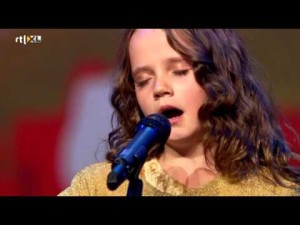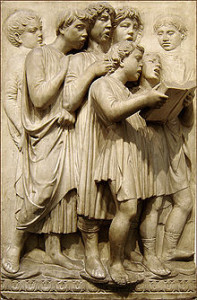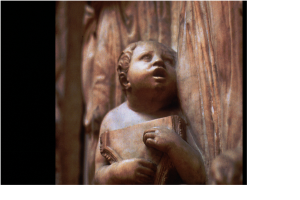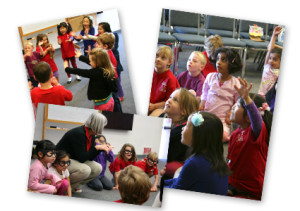 I’ve reported Dr. Bruce Perry’s in Washington May 4 to talk on healing trauma at the National Council.
I’ve reported Dr. Bruce Perry’s in Washington May 4 to talk on healing trauma at the National Council.
What’s that got to do with this sculpture of children singing in the Cathedral of Florence in 1436 to kick off the Renaissance? Everything!
Dr. Perry says it’s brain science to regulate the brain stem with “patterned, repetitive, rhythmic regulation,” featuring yoga, meditation, deep breathing, and singing, principles so fundamental they go back to the dawn of man. [FN1]
Who can imagine life without singing? In every culture, long before writing, the only way to pass down an idea was to sing it. Aryans have sung Vedas since 5,000 BC or before. Hebrews sang Psalms as far back as 2,500 BC, long before they were written down ca. 1400 BC. [FN2 ]
Want to regulate kids? Teach them to sing! Gathering children to sing in choirs was the core of the Greek educational system since at least 700 BC, and there were choir schools for kids in Europe at least since the 900s AD. [FN3] Singing in choirs brings kids into organized personal connection with other living, regularly-breathing human beings. Being connected and in harmony with other humans is what best regulates human beings – today brain scientists call it “limbic resonance.” [FN4]
 Singing gives kids a voice! Children have been known to sing gloriously even today. Watch 9-year old Amira Willighagen sing in Amsterdam last year.
Singing gives kids a voice! Children have been known to sing gloriously even today. Watch 9-year old Amira Willighagen sing in Amsterdam last year.
She did it without any training. Amira just went on the internet looking for songs, found this Italian aria, and learned it by imitating. Clearly she found a terrific adult soprano – we can hear the inflections of a highly-experienced adult in Amira’s voice. [FN5]
 Or take the St. Thomas Boys Choir of Leipzig. When J.S. Bach became music director in 1723, the choir school was already 511 years old. Click here for the boys singing a Bach “Gloria.” [FN6]
Or take the St. Thomas Boys Choir of Leipzig. When J.S. Bach became music director in 1723, the choir school was already 511 years old. Click here for the boys singing a Bach “Gloria.” [FN6]
Born to Sing
 If a child can speak, he can sing; most kids can sing before they can speak. Training children to sing as young as possible is a principle of civilization. Electronic culture has forgotten it to our peril as our kids whack out on machine-made noise. We need a revolutionary approach as old as the hills. We need children’s choirs on a mass scale.
If a child can speak, he can sing; most kids can sing before they can speak. Training children to sing as young as possible is a principle of civilization. Electronic culture has forgotten it to our peril as our kids whack out on machine-made noise. We need a revolutionary approach as old as the hills. We need children’s choirs on a mass scale.
These children singing on the “Cantoria” by Lucca della Robbia, sculpted 1431-36, were placed in the Cathedral as public ads, to urge parents to bring in their kids for training. This is the level of culture and education which later produced Bach, Haydn, Schubert and Beethoven. Was their genius just magic? Why don’t we have composers today, who produce music on such a scale (and they did it all without electronic equipment) ?
Answer: Bach & co. were trained as children to sing harmonic, complex polyphony (4-6 different musical lines at once). So complex, harmonic music was what they heard in their heads as little kids. They were bilingual; music was their second mother tongue. To them, it was simple: as soon as they could hold a pen, they would just start to write down their musical ideas. That tradition continued in Europe until the end of the 19th Century.
And there’s another reason everybody loves music: it’s because every body loves music. Music is literally built into kids’ bodies from the hour of conception. Our bodies physically need it. And kids know that instinctively, from infancy.
“The first music encoded deep within your memory are the earliest vibrations that made you – the rhythms and tempos of your first cells,” writes Galina Mindlin, MD and music therapist.
“As your cells began to develop with the rhythms of your mother’s heartbeat and the whooshing sounds vibrating through her placenta and your umbilical cord, these first musical scores began entraining (two or more rhythms synchronizing into one) in your brain… your brain was already establishing the relationship for how music affects you today… Newborns can almost immediately show some memory of sounds they encountered in the womb… Before any of us is capable of speaking words, we can recognize changes in notes and rhythmic patterns…” [FN7]
The Mother of All Trauma
 What about trauma healing? Consider this: from 1348-1350, the Black Death, the mother of all trauma, killed half the population of Asia and Europe. In Italy, Florence’s population was reduced from 120,000 in 1338 to 50,000 in 1351. Many thought civilization was finished. [FN8]
What about trauma healing? Consider this: from 1348-1350, the Black Death, the mother of all trauma, killed half the population of Asia and Europe. In Italy, Florence’s population was reduced from 120,000 in 1338 to 50,000 in 1351. Many thought civilization was finished. [FN8]
Then a handful of intellectuals devised the idea of a re-birth or “Renaissance,” a project to unite a new economics to feed the population, with the science, philosophy, and arts to uplift them. Florence had a famous problem whose solution could inspire people with hope. At the city’s center lay the massive Cathedral of Florence, begun 1296 — but no one had any idea how a dome could be built large enough to cover such a space without collapsing. Work was also delayed by waves of plague for decades. The roof lay open for over a century as people prayed in the rain.
During 1402–1404, Filippo Brunelleschi and his friend Donatello visited Rome to study the ancient ruins and the Pantheon on which the Cathedral was modeled. They returned to build the first “classical” buildings in Florence. In 1420, Florentine banker Cosimo de’ Medici (1389-1464) bankrolled Brunelleschi to work 16 years to complete the first octagonal dome in history to be built without a wooden supporting frame. [FN9]
What did they do in that Cathedral? They brought in the children of the city and taught them to sing, to show there was hope for the future, that the children could be saved from the jaws of death. These sculptures just above show that by the age of 9-11, kids were singing (and playing) complex four and six part polyphony.
Note the rounded mouths in all the sculptures (and in the St. Thomas boys). Vocal scholars can tell you what note they’re singing by how large of an egg-shaped mouth they’re making.
The dome was ready in time for the Council of Florence which opened in the Cathedral on March 25, 1436, the date often cited as the start of the Renaissance. Inside were featured these sculptures of children singing in the choir loft by Lucca della Robbia. Flemish composer Guillaume Dufay and many of his colleagues were brought to Italy to teach advanced musical composition. Dufay’s advanced motet Nuper rosarum flores was composed for the 1436 opening and sung from della Robbia’s choir loft by kids like these in the sculptures.
Cosimo de’ Medici and his grandson Lorenzo de’ Medici (1449-1492) also backed philosophers Marsilio Ficino and Pico della Mirandola. Pico’s 1486 “Oration on the Dignity of Man” stated the Renaissance Idea: each individual human soul is a divine spark of God, not a beast of burden as under feudalism.
 These sculptures show that in Florence, the Dignity of Man began with the dignity of the children. These kids have been taught to sing even younger, at 5 to 8 years. Della Robbia did several sculptures of toddlers singing as well (more than I have space to show!).
These sculptures show that in Florence, the Dignity of Man began with the dignity of the children. These kids have been taught to sing even younger, at 5 to 8 years. Della Robbia did several sculptures of toddlers singing as well (more than I have space to show!).
 Even infants sang, singing with their families perhaps while they learned to speak.This child is not much older than 2. Kids who started this early acquired the experience it took to produce genius in many fields.
Even infants sang, singing with their families perhaps while they learned to speak.This child is not much older than 2. Kids who started this early acquired the experience it took to produce genius in many fields.
San Diego Trauma-Informed Renaissance?
I’ve seen this kind of singing of fine music in choirs make traumatized children happy. Musicians who run children’s choirs will tell you that.
 The San Diego Children’s Choir (right), founded 1990, now has 5 branches with over 250 participants. It also has a neighborhood outreach program that spans many low-income areas full of traumatized children including City Heights and other areas.
The San Diego Children’s Choir (right), founded 1990, now has 5 branches with over 250 participants. It also has a neighborhood outreach program that spans many low-income areas full of traumatized children including City Heights and other areas.
City Heights is also where Principal Godwin Higa has been turning Cherokee Point Elementary into an advanced trauma-infomed school since 2008. Three professors at San Diego State and community organizers Dana Brown and Dorothy Zirkle worked with the City Heights community to develop a two-year $684,094 pilot project at Cherokee Point, the Wellness and Restorative Practice Partnership (WRPP), funded by the California Endowment.
I can’t be with Bruce Perry in Washington May 4, but I will be in San Diego May 2, talking to my friend Dana Brown and other members of the San Diego Trauma-Informed Guide Team (SD-TIGT) about Bruce Perry, Bessel van der Kolk, and the brain science of trauma. SD-TIGT is leading the way among county health and welfare institutions to implement trauma-prevention and trauma-healing practices in schools, medical, and social facilities.
If Principal Higa and Dana haven’t met the folks at the San Diego Children’s Choir yet, maybe I’ll be able to provoke something. Even if they’ve met, maybe we can expand their forces. As a result of the economic crisis, San Diego just lost its opera company, the San Diego Opera. The city must be full of struggling singers, school music teachers and private voice teachers who would jump at the chance to teach every child at Cherokee El to sing Bach.
Next step: find our Cosimo de’ Medici to pay these already financially-pressed musicians and educators, so they can put in the hours necessary every week at Cherokee El. Then stand back.
—————————–
Kathy’s news blogs expand on her book “DON’T TRY THIS AT HOME: The Silent Epidemic of Attachment Disorder—How I accidentally regressed myself back to infancy and healed it all.” Watch for the continuing series each Friday, as she explores her journey of recovery by learning the hard way about Attachment Disorder in adults, adult Attachment Theory, and the Adult Attachment Interview.
——————————
Footnotes
FN1 Lucca della Robbia, Cantoria (Choir Loft), shows children singing, dancing,and making music to “praise the Lord” in the words of Psalm 150. Photos at http://commons.wikimedia.org/wiki/File:Cantoria_di_luca_della_robbia_11.jpg
FN2 http://en.wikipedia.org/wiki/The_Arctic_Home_in_the_Vedas
FN3 Chorus members in Greek theater were trained in childhood from around 700 BC. Greek theater always included a chorus, whose members also danced and spoke, but also sang. [http://en.wikipedia.org/wiki/Greek_chorus ] Both boys and girls were trained to sing. [http://www.amazon.com/Choruses-Young-Women-Ancient-Greece/dp/0742515249 ] Greece and Rome founded many children’s singing schools [ http://www.boychoirs.org/library/history/hist014.html ] The Schola Cantorum in Rome was formed in the seventh century to train boys in reading and singing.
The Vienna Boys Choir, formalized in a 1498 letter by Maximilian I Habsburg, goes back to the year 957 when Bishop Wolfgang of Regensburg created his cathedral choir [ http://www.boychoirs.org/library/history/hist014.html and http://en.wikipedia.org/wiki/Vienna_Boys%27_Choir ] The first choir school was founded at St. Paul’s Cathedral, London in 1127, the second at St. Thomas’ Church, Leipzig in 1212. A boarding school for choristers at the Kreuzkirche in Dresden is mentioned in 1300, a choir known now as the Dresdner Kreuzchor. The Vienna Boys Choir received a solid musical education, many went on to become professional musicians such as Franz Schubert.
[ http://en.wikipedia.org/wiki/Choir ].
FN4 Lewis, Thomas, MD; Amini, Fari, MD; Lannon, Richard, MD; “A General Theory of Love”, Random House, New York, 2000. Lannon interviews : www.paulagordon.com/shows/lannon/
FN5 Amira Willighagen video: http://news.distractify.com/default-category/a-shy-9-year-old-girl-takes-the-stage-these-people-will-never-forget-what-follows/
FN6 St.Thomas Choir video: https://www.youtube.com/watch?v=A-apSehviiQ&list=PL517BEEF15EA64268
FN7 Mindlin, Galina, MD, PhD, “Your Playlist Can Change Your Life,” Sourcebooks, Inc., Naperville, IL, 2012 More here:
www.nicabm.com/nicabmblog/what-healthy-brains-sound-like-how-brain-music-therapy-is-helping-first-responders/
FN8 The Black Death was one of the most devastating pandemics in human history, peaking in Europe between 1348 and 1350 with 30–60 percent of Europe’s population killed. It reduced world population from an estimated 450 million to between 350 and 375 million in the 14th century. http://en.wikipedia.org/wiki/Consequences_of_the_Black_Death
FN9 Walker, Paul Robert, “The Feud That Sparked the Renaissance: How Brunelleschi and Ghiberti Changed the Art World,” Harper Collins, 2003
![]()



Pingback: Music Therapy and Child Trauma | "Don't Try This at Home"
Thanks! I haven’t been writing on my blog much lately, life is too complicated and literally too close to home! I am looking forward to hearing more of your work! Linda
Pingback: +HEALING KID TRAUMA: RHYTHM AND SINGING | Stop the Storm
The children’s choir and orchestra performing Bach’s “Gloria” from the Mass in B minor brought tears to my eyes. I remember the joy I felt throughout my life, beginning before I went to kindergarten, that singing has brought me. Without it I feel like I am simultaneously drowning and starving. Drowning in a sea of troubles and starving for happiness, connection, and joy at being in the world. It saddens me no end that the powers that be in control of our schools fail to understand the spiritual nourishment necessary to our children, preferring instead to drown them in a sea of electronic, emotionless, addicting gadgetry, cookie cutter education, overloaded, and overcrowded classrooms.